Disclaimer: This post may contain Amazon affiliate links. Sudachi earns a small percentage from qualifying purchases at no extra cost to you. See disclaimer for more info.
What is Ajitama Egg? (Nitamago/Ajitsuke Tamago)
Ajitama (味玉) is a dish made by marinating boiled eggs in a special soy sauce base broth or sauce. It is also known as “ajitsuke tamago” (味付け卵), “nitamago” (煮卵), or simply “ramen egg” in English because it is most often used as a topping in ramen dishes.
Even though ajitama eggs are most commonly seen on ramen dishes, we also eat them as a snack in Japan. It’s easy to buy them already flavored in the supermarket too!
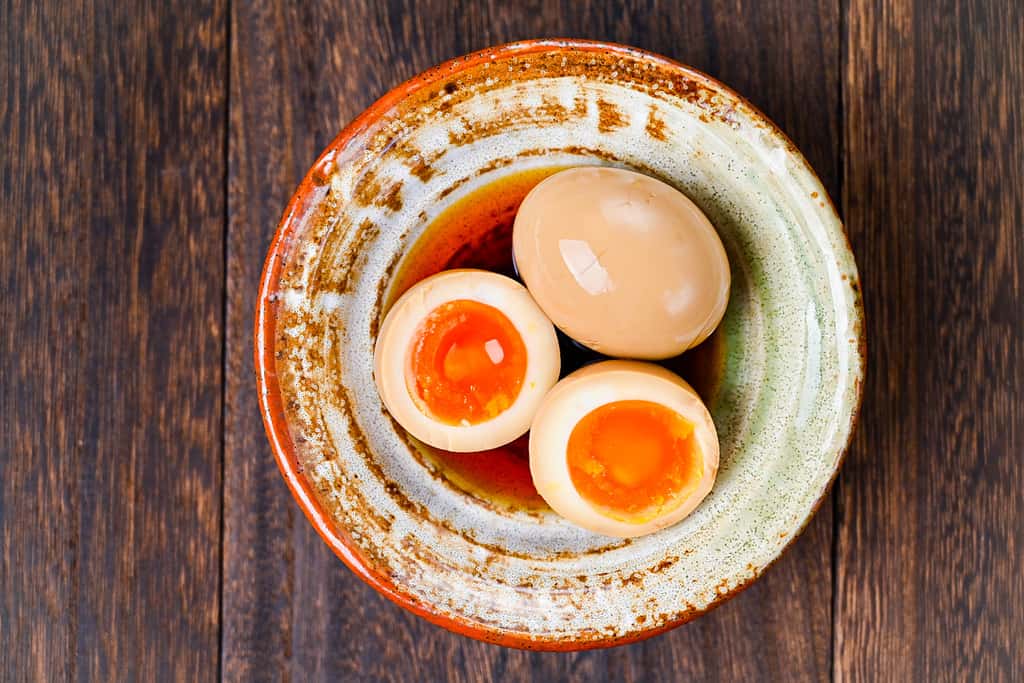

How I Developed This Recipe
When I was creating this Ajitama Eggs recipe, I envisioned crafting the ultimate go-to topping for every ramen bowl I’d prepare in the future.
I aimed for simplicity in the process, ensuring that the yolks would be perfectly semi-cooked, delivering that luscious, slightly runny heart encased in a soft, tender white.
After much experimentation and fine-tuning, I believe I’ve created the best topping for ramen — one that elevates each bowl into a more delightful experience. Whether nestled atop a steamy bowl of ramen or enjoyed as a savory snack on its own, I hope you find these Ajitama Eggs as irresistible as I do!
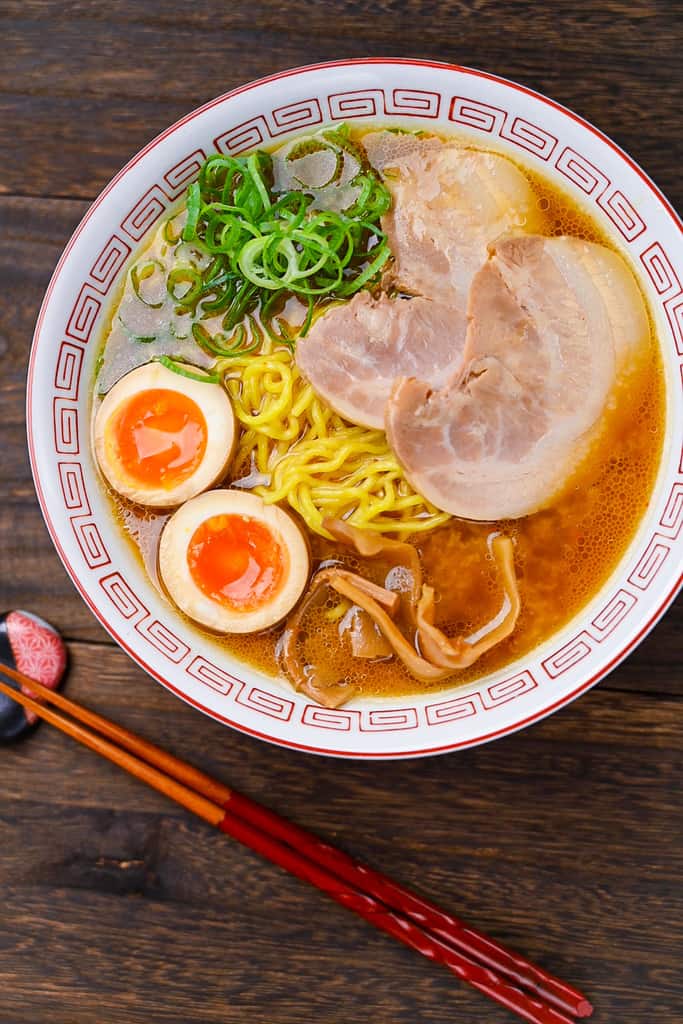
Ingredients & Substitution Ideas
- Tsuyu sauce – This is a concentrated condiment made with dashi (Japanese soup stock), soy sauce, mirin (sweet cooking sake), and sugar. You can either use a store-bought one like this, or I have instructions on how to make homemade tsuyu sauce.
- Soy sauce – If you want to know more about soy sauce used for Japanese cooking, please see my 20 Most Useful Condiments and Seasonings for Japanese Cooking post.
- Water – Use to thin the marinade slightly.
- Mirin – Choosing the right mirin can be tricky, as there are various “mirin-style condiments” that are not true mirin. When purchasing mirin, it is recommended to look for “hon mirin” (本みりん) for the best flavor. In the US, Hinode Hon Mirin is a high-quality and affordable option.
- Sake – If you do not have it, substitute white wine or dry sherry.
- Sugar – I use light brown sugar, but white sugar is also fine.
- Medium-sized eggs – Use pasteurized eggs, as they are eaten half-cooked.
- Salt – Regular sea salt used for general cooking.
Curious about the exact brands and products that bring my recipes to life? Discover the brands and ingredients behind my recipes at the Sudachi Amazon Storefront. Explore my handpicked pantry essentials and find your next kitchen favorites!
Jump to Full Recipe MeasurementsBoiling an Egg: Timing, Techniques, and Tips
Ajiatama, especially the ones used for ramen, is always soft-boiled! It’s one of their characteristics! Here is my way to get perfect soft-boiled eggs every time!
- Firstly, ensure the pan fits enough water to cover your eggs completely.
- Bring the water to a gentle rolling boil and carefully lower your eggs using a ladle. (The eggs should be cold and straight from the fridge.)
- Set the timer for 7 minutes to achieve firm whites and outer yolk with a soft, slightly runny center.
- As soon as the timer is up, put the eggs straight into ice-cold water to stop cooking. If you skip this step, the eggs will continue to cook with the residual heat, leading to firm yolks.
- Cool for 10-15 minutes, and peel them in a bowl of water. Once the shell is cracked, the water will seep in and help separate it from the egg, making it easier to peel.
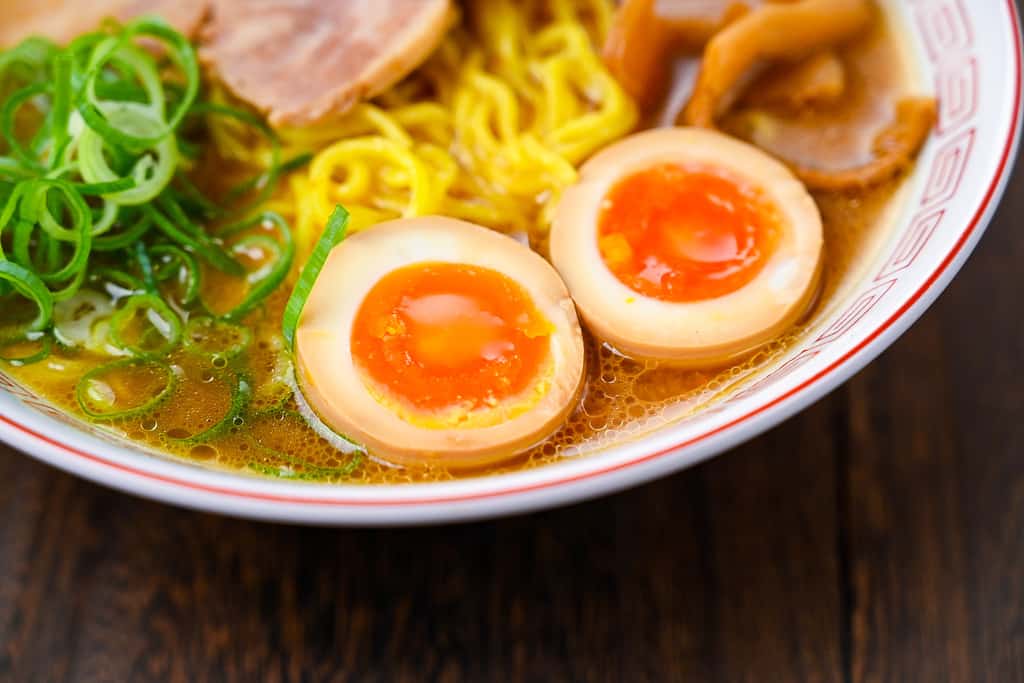
Visual Walkthrough & Tips
Here are my step-by-step instructions for how to make Ajitama Eggs at home. For ingredient quantities and simplified instructions, scroll down for the Printable Recipe Card below.
Add tsuyu sauce, soy sauce, water, mirin, sake and sugar to a saucepan and bring to a boil over a medium heat. Boil for 1-2 minutes to cook off the alcohol in the sake and mirin, then remove from the heat and leave to cool.
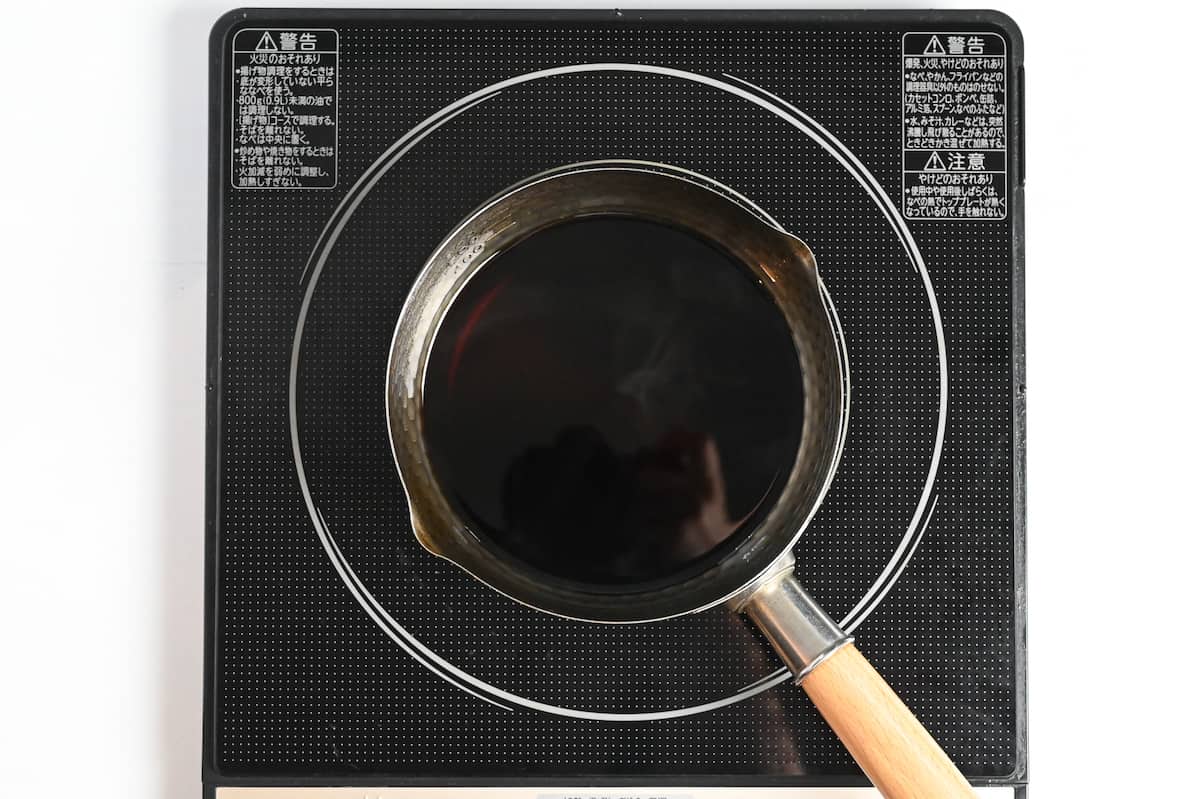
Bring a pot of water to a rolling boil and add salt. Keep the eggs in the fridge until it’s time to add them to the water. Salt water will help prevent the egg white from leaking out if the shell happens to break.
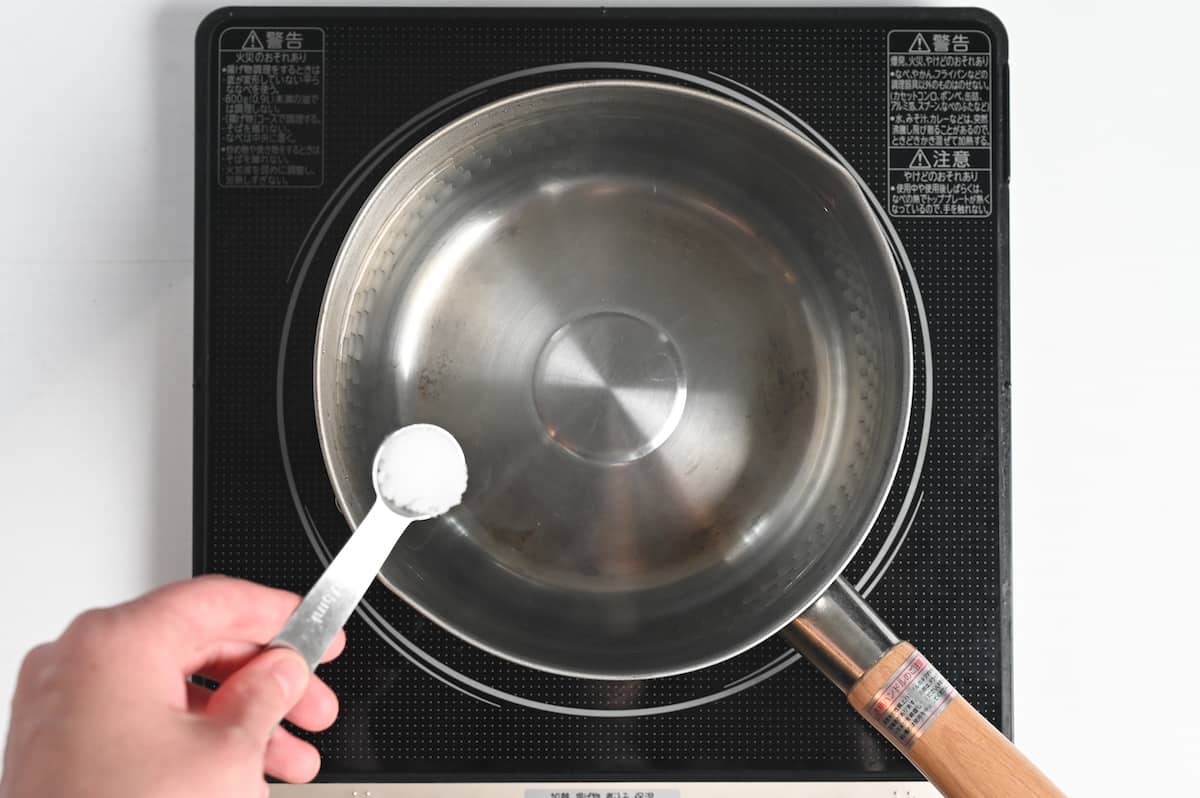
Once the water is boiling, use a ladle to gently lower the eggs into the pot to prevent them from breaking.
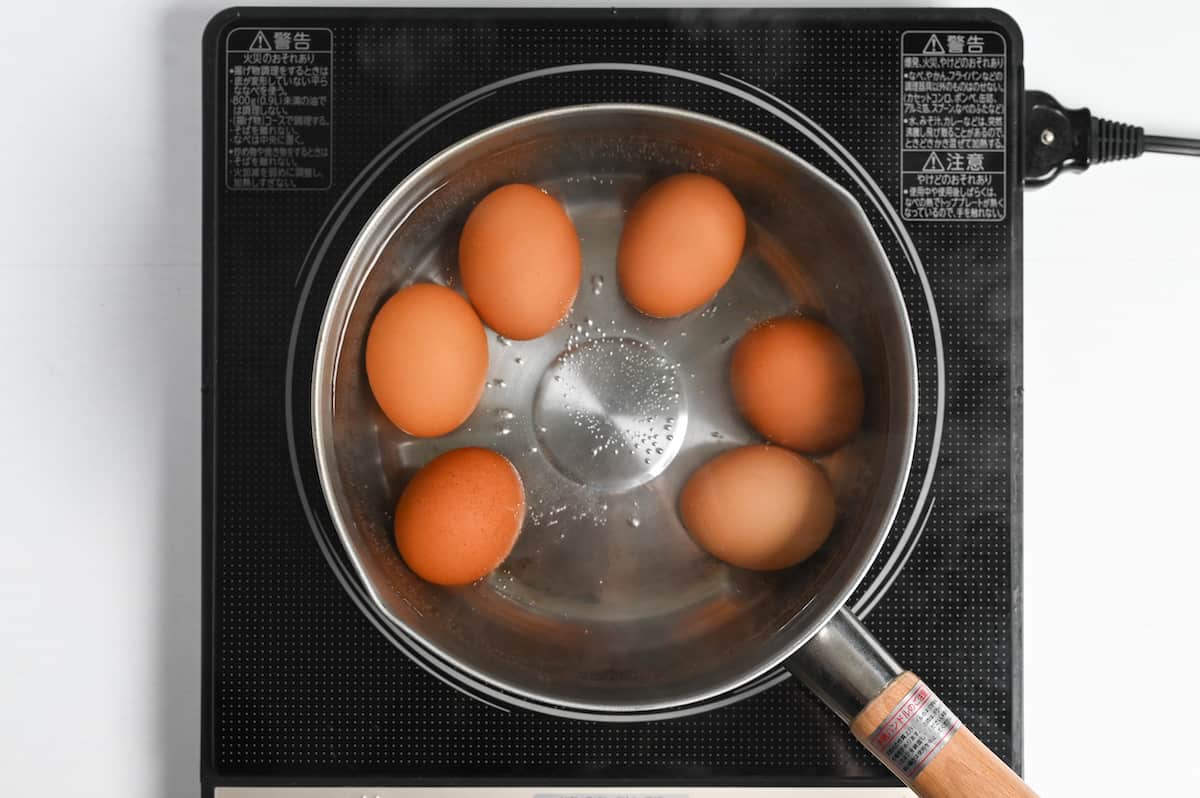
As soon as the eggs are in the pot, set a timer for 7 minutes. This will cook the egg whites and the outside of the yolk, but leave the center slightly runny. (If you don’t like runny yolks, feel free to cook them for up to 9 minutes for a hard boiled egg.)
Place a lid on it to stop the water from evaporating.
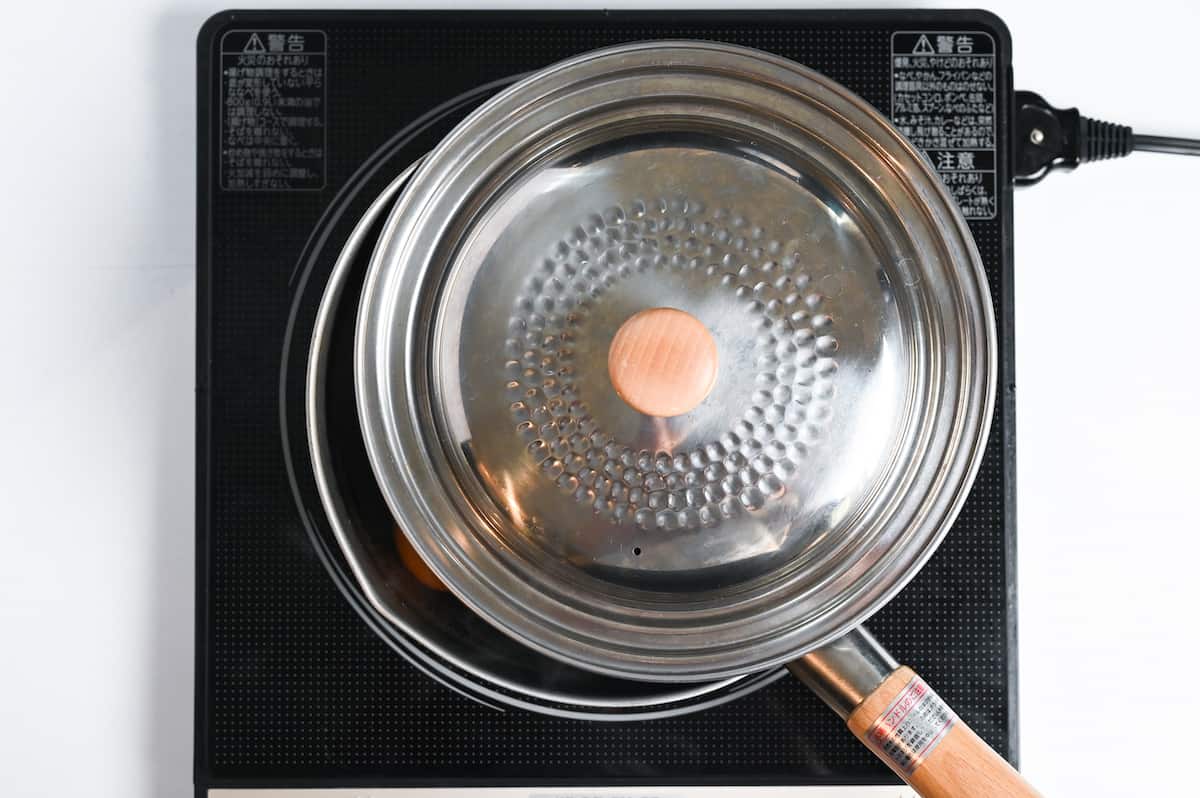
While you wait for the eggs to cook, prepare a bowl of ice water.
After the timer goes off, transfer the eggs straight to a bowl of ice-cold water. This halts the cooking process and prevents the yolk from becoming overcooked. Leave to cool for 10 minutes.
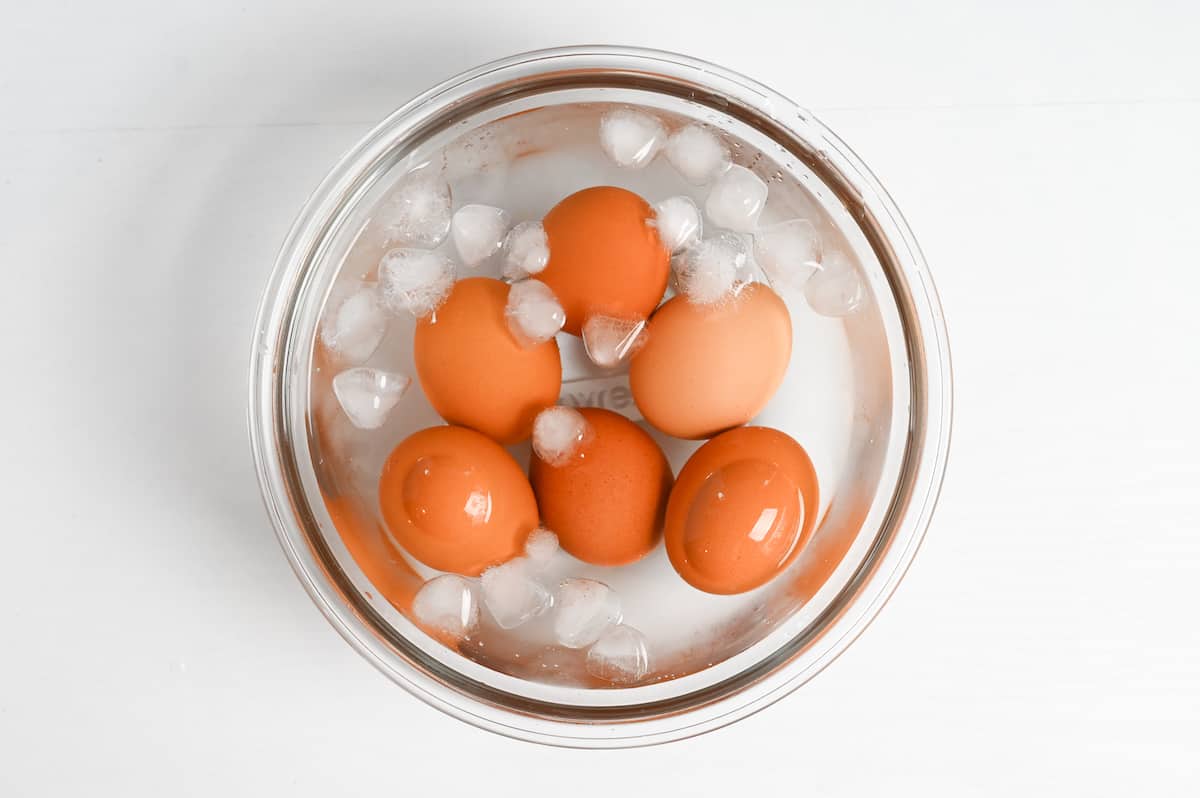
Peel the shells off of the eggs and dry them with kitchen paper. Drying them will stop your marinade from becoming watered down.
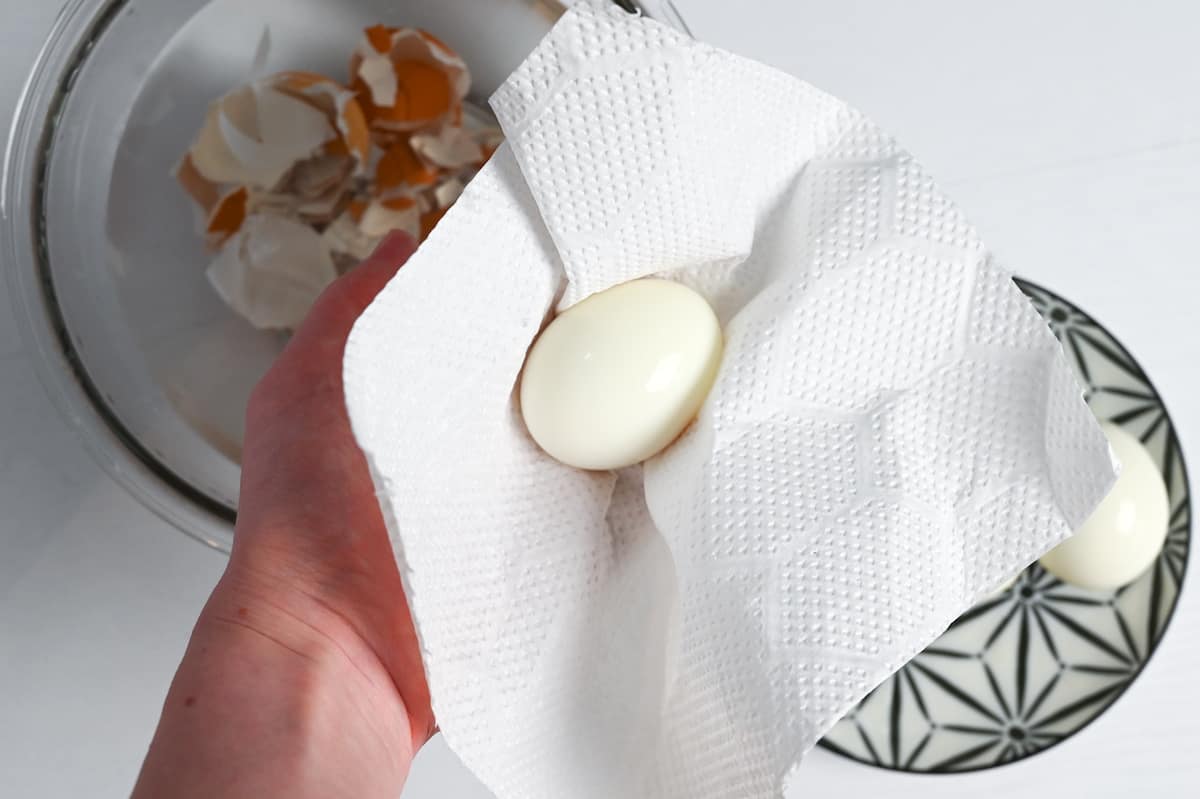
The marinade should be cool by now, so pour it into a ziplock bag and add the soft-boiled eggs. The marinade must be cool before adding the eggs! If it’s still warm, wait a bit longer.
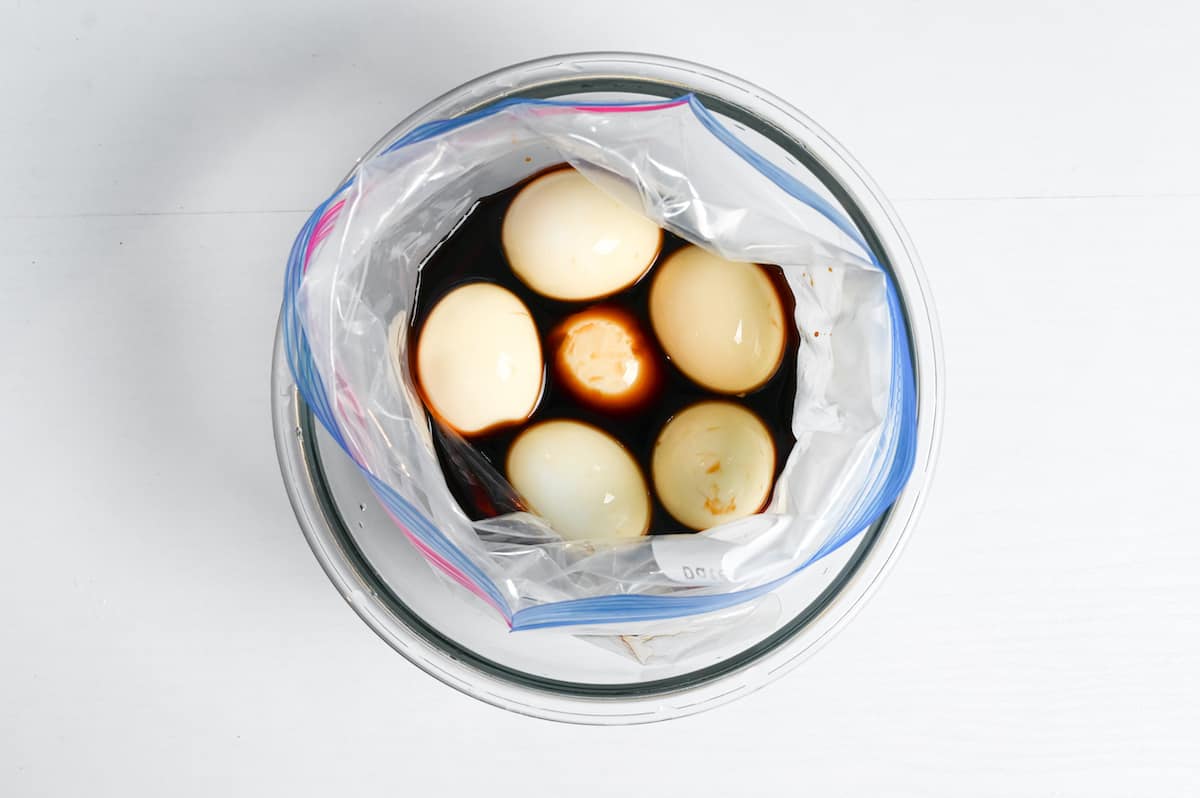
The reason I use a ziplock bag is that I only use a small amount of marinade, and the ziplock bag makes it easy to ensure all of the eggs are covered. If you use a square container, you will need more marinade OR you will need to turn the eggs occasionally to ensure they’re evenly flavored.
Seal the bag and place it on a tray in the refrigerator. The tray helps prevent leaks (just in case!).
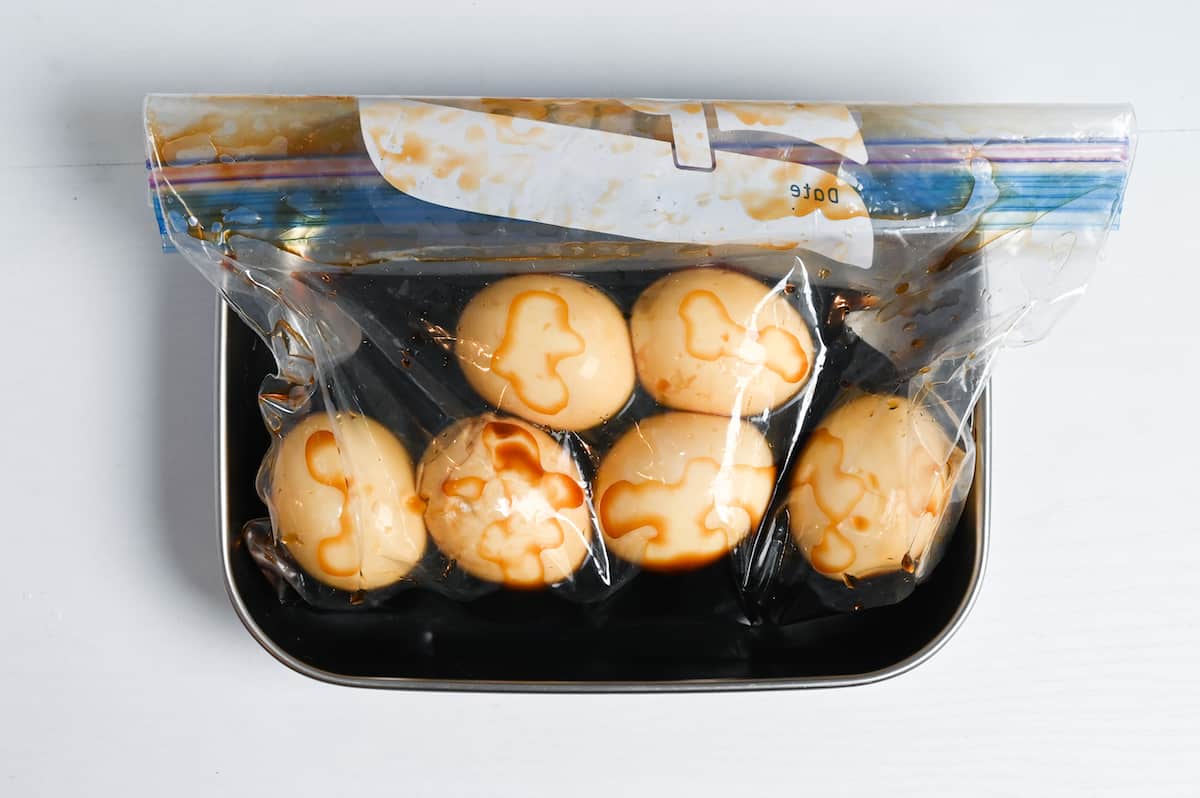
Marinate for at least 45 minutes up to overnight.
Enjoy your perfectly cooked and seasoned soft-boiled Ajitama Eggs on top of your favorite ramen or as a satisfying snack!
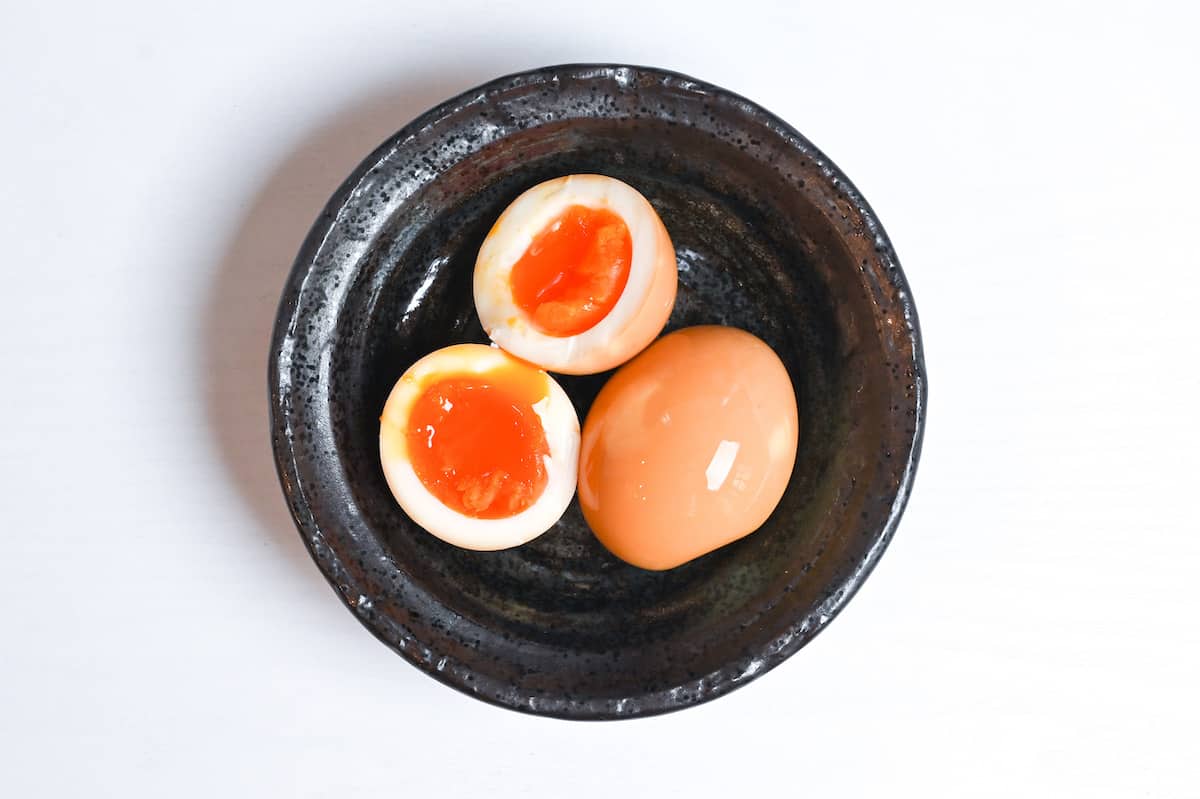
How to Store
The best way to store ajitsuke tamago is to keep them in the refrigerator in a sealed container soaking in the marinade. Since the marinade is quite salty, it helps preserve the eggs longer.
Keep in mind that the longer the eggs are in the marinade, the stronger the taste will be. You can store them in the marinade for about 3-4 days.
If you find the taste starts to become too strong for your liking, remove them from the marinade and store them in a new, clean container. Consume within 24 hours of removing them from the marinade.
FAQ
The well-loved ajitama, one of the most ramen toppings, has an origin story that might raise a few eyebrows. One theory suggests that its roots trace back to Taiwan. There, a notable dish known as Danzai noodles sometimes comes topped with a boiled egg marinated in soy sauce. Many believe this Taiwanese dish served as the muse for what we now know in Japan as “ajitama.”
While its true origins remain a bit hazy, one thing’s almost certain: Kan Chin Tei (now closed), a ramen joint tucked away in Ogikubo, Tokyo, is credited as the first in Japan to introduce ajitama as a ramen topping. However, it was at another eatery, Chibakiya, where soft-boiled eggs made their ramen debut. The man behind this innovation was a chef (Kenji Chiba) who originally specialized in traditional Japanese cuisine.
Chiba found himself awestruck by Taishoken, a ramen restaurant where people queued up just for a taste of their incredible noodles regardless of the look and atmosphere. At the age of 40, he left his executive chef position and decided to follow his newfound passion for ramen.
Before Chiba, the eggs on ramen were typically hard-boiled or had a heavily seasoned surface. Using the culinary techniques he’d learned from traditional Japanese cuisine, he pioneered the perfect soft-boiled egg, a game-changer in the world of ramen.
Nowadays, you’ll find half-boiled ajitama in nearly every ramen restaurant, but before Chibakiya, this innovation was simply not a part of the ramen scene. Chiba’s contribution was not just an ingredient; it was a transformation of tradition.
You might have noticed that I’ve been using “Ajitama,” “Ajitsuke tamago,” and “Nitamago” to describe this delicious egg dish. So, you’re probably wondering, “What’s the difference?” In short, ajitama is just an abbreviation of ajitsuke tamago, so they’re exactly the same thing. But Nitamago, strictly speaking, is a little different.
Here’s how it breaks down: Ajitama is mostly soft-boiled and flavored by being placed in a container like Tupperware or a Ziploc bag with marinade added to it. Nitamago, on the other hand, starts as a boiled egg, which is then simmered further in a pot with seasoned broth, resulting in a hard-boiled egg. For example, a nitamago would be made by boiling a boiled egg with Kakuni (Japanese braised pork belly) or Oden (Japanese winter stew).
However, the line between the two has become quite blurry these days, and half-boiled eggs also started to be called nitamago. If you google nitamago recipes in Japanese, you’ll mostly find recipes with half-boiled eggs. Perhaps hard-boiled nitamago has fallen out of favor in the face of the popularity of half-boiled eggs in general. So, all in all, it does not really matter which term you use to describe marinated soft-boiled eggs to use for ramen.
When a recipe calls for “sake” on Sudachi, I use pure sake without added salt. Cooking sake with salt requires adjusting the recipe’s salt content. All dishes on Sudachi use drinking sake. For more on sake in Japanese cooking, see the “Sake 101” post by a 30+ year industry veteran.
We usually don’t reheat them as you can risk making the yolk too firm. The ramen egg tends to warm up in the ramen soup. If you really want to reheat them, you can place them in hot water, no warmer than 70C/158F to ensure they don’t start cooking again.
They should be kept in the fridge and eaten within 3-4 days in the marinade or 24 hours once removed from the marinade.
Not only does the marinade lose its flavor after soaking the first batch of eggs, but reusing it increases the risk of bacteria forming. The marinade can only be kept for 3-4 days which means that each batch of eggs will have a shorter life. I recommend making a new marinade for every batch of ramen eggs.
I hope you enjoy this Ajitama recipe! If you try it out, I’d really appreciate it if you could spare a moment to let me know what you thought by giving a review and star rating in the comments below. It’s also helpful to share any adjustments you made to the recipe with our other readers. Thank you!
Recommended Recipes to Use
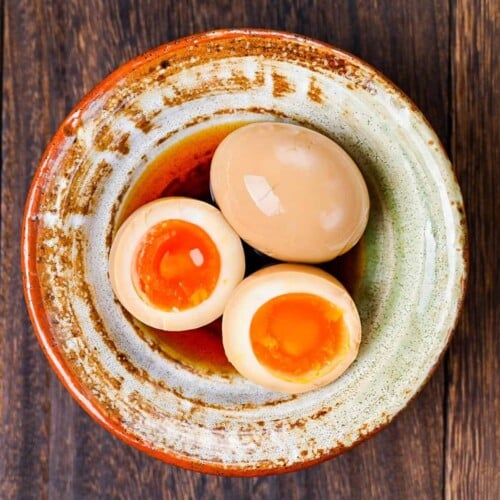
Ajitama Egg (Nitamago/Ajitsuke Tamago)
Ingredients
- 75 ml tsuyu sauce vegetarians should use tsuyu sauce with kombu base
- 25 ml soy sauce
- 75 ml water
- 25 ml mirin
- 10 ml sake
- 4 g sugar
- water
- 1 tsp salt
- 6 egg
- 1 bowl ice-cold water
Instructions
- In a small pan, add 75 ml tsuyu sauce, 25 ml soy sauce, 75 ml water, 25 ml mirin, 10 ml sake and 4 g sugar. Mix and bring to a boil over a medium heat. Boil for 1-2 minutes, then remove from the heat and leave to cool.

- Next, bring a pan of water to a rolling boil and mix in 1 tsp salt. (It should be enough water to completely cover the eggs)

- Add 6 egg to the pot and set a timer for 7 minutes to make soft-boiled eggs. (Increase the time to up to 9 minutes for a firmer yolk.)

- Place a lid on top to stop the water from evaporating.

- Once the time is up, immediately transfer the eggs into a 1 bowl ice-cold water to halt the cooking process.

- Leave the eggs to cool for about 10 minutes and then peel them in the water. Dry with kitchen paper to prevent watering down the marinade.

- Once the sauce is cool, place the eggs and sauce together in a zip-lock bag and store them in the fridge for 45 minutes. (Tip – place the bag on a tray to prevent any leaks or spills!)

- Enjoy with ramen or as a snack!





Leave a rating and a comment